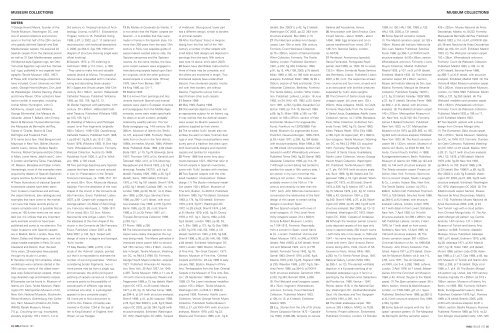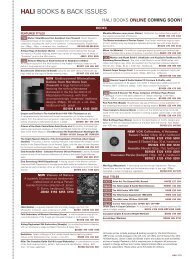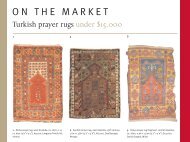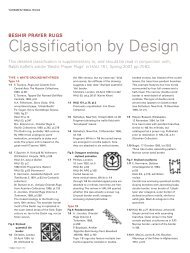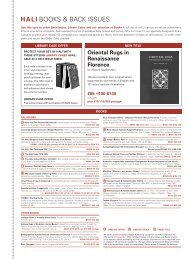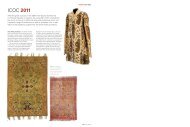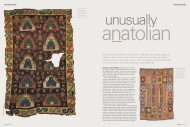2: IBERIAN & EAST MEDITERRANEAN CARPETS IN THE - Hali
2: IBERIAN & EAST MEDITERRANEAN CARPETS IN THE - Hali
2: IBERIAN & EAST MEDITERRANEAN CARPETS IN THE - Hali
Create successful ePaper yourself
Turn your PDF publications into a flip-book with our unique Google optimized e-Paper software.
MUSEUM COLLECTIONS<br />
NOTES<br />
1 George Hewitt Myers, founder of the<br />
Textile Museum, Washington DC, was<br />
one of several collectors and connoisseurs<br />
in the first half of the 20th century<br />
who greatly admired Spanish and East<br />
Mediterranean carpets. He acquired 22<br />
Spanish carpets from the classical period<br />
as well as 31 East Mediterranean carpets<br />
(16 Mamluk-style Egyptian rugs, ten Ottoman-style<br />
Egyptian rugs and five ‘Damascus’<br />
rugs), published in two separate monographs<br />
(Textile Museum 1953, 1957).<br />
2 Those with important large collections<br />
have included: Count Johannes von Welczeck,<br />
George Hewitt Meyers, Don José<br />
de Weissberger, Charles Deering, Wendy<br />
and Emery Reves. Other collectors have<br />
had a number of examples, including:<br />
Archer Milton Huntington, John D.<br />
McIlhenny, Joseph Lees Williams,<br />
George Blumenthal, the Marquis de<br />
Valverde, James F. Ballard, John Emery,<br />
Baron & Baroness Thyssen-Bornemisza,<br />
the Marquesa de Bermejillo del Rey,<br />
Sidney A. Charlat, Marino & Clara<br />
Dall’Oglio and Frederick Pratt.<br />
3 To name but a few: Vitall Benguiat and<br />
Mayorcas in New York; Böhler, Munich;<br />
Adolfo Loewi, Venice; Stefano Bardini,<br />
Florence; Michel Campana and Elio Cittone<br />
in Milan; Lionel Harris, Jekyll’s and C. John<br />
in London; and Sammy Tarica, Yves Mikaeloff,<br />
Masson, Benadava and Catan in Paris.<br />
Interestingly, most of the examples were<br />
acquired by dealers of Spanish Sephardic<br />
origins and few by Armenian dealers.<br />
4 These illustrations of classical Spanish<br />
knotted-pile carpets have been taken<br />
from museum inventories and archives,<br />
the carpet literature, sale catalogues and<br />
examples that have come to the market.<br />
I am sure that these records are by no<br />
means complete and it is possible that as<br />
many as 150 further items are not recorded,<br />
but it is unlikely that any important<br />
early example would not have been<br />
published and come to my attention. The<br />
major museums with Spanish carpets<br />
are in Madrid, Berlin, London, New York,<br />
Miami, Dallas and Washington, with individual<br />
notable examples in Paris, St Louis,<br />
Cleveland and Detroit. Over the past<br />
thirty years, 29 examples have passed<br />
through my studio in London.<br />
5 The latter coming from Arraiolos, where<br />
workshops were certainly started in the<br />
16th century; many of the oldest examples<br />
copy Safavid Iranian carpets, others<br />
copy Anatolian rugs and Arraiolos carpets.<br />
6 Examples can be found in: Museum of<br />
Islamic Art, Cairo; Textile Museum, Washington<br />
DC; Metropolitan Museum of Art,<br />
New York; National Museum, Stockholm;<br />
Röhss Museum, Gothenburg; Keir Collection,<br />
Ham; Museum of Islamic Art, Doha<br />
(MIAQ), Benaki Museum, Athens.<br />
7 E.g., Crouching lion rug. Incomplete,<br />
possibly originally 178 x 312cm. 1st to<br />
84 HALI ISSUE 157<br />
3rd century AD. Xinjiang Institute of Archaeology,<br />
Urumqi, no.M15:1. Excavated at<br />
Yingpan, tomb no.15. Published: König<br />
1999, p.87; Li 2002, pp.7, 11 (detail and<br />
reconstruction, with technical description);<br />
Li 2006, pp.254–5, figs.198, 199 (with<br />
diagram of structure showing single warp<br />
offset knotting).<br />
8 Serjeant 1972, p.175 (referring to<br />
Al-Himyari 1938, p.112, trans., p.138):<br />
“They used to make fine and valuable<br />
carpets (busut) at Murcia. The people of<br />
Murcia have unequalled skill in manufacturing<br />
and decorating these carpets.”<br />
9 (1) Sages and Virtues carpet. Mid-12th<br />
century. 64 x 182cm, section. Halberstadt<br />
Cathedral Treasury. Published: Wilckens<br />
1992, pp.103, 105, figs.10, 12.<br />
(2) Border fragment with palmettes. 12th<br />
century. 20 x 400cm. Halberstadt Cathedral<br />
Treasury. Published: Wilckens 1992,<br />
pp.103, 105, fig.13.<br />
(3) Wedding of Mercury and Philologia<br />
carpet. (a–e) Five fragments (originally<br />
590 x 740cm). 1186–1203. Quedlinburg<br />
Cathedral Treasury. Published: Kurth 1926,<br />
I, pp.53–67, fig.26,II, pls.12–21, 22b;<br />
Nickel 1976; Wilckens 1992. (f) One fragment.<br />
Whereabouts unknown. Formerly:<br />
Welczek Collection, Austria (to 1945).<br />
Published: Kurth 1926, II, pl.21a; Wilckens<br />
1992, p.100 (cited).<br />
10 Two paintings depicting early Spanish<br />
carpets that have been cut and reduced<br />
in size: (1) Presentation in the Temple.<br />
Francisco Henriques, ca. 1508–1511. Oil<br />
on wood, 88 x 15cm. Museu de Alpiarça,<br />
Alpiarça. From the altarpiece of the main<br />
chapel of the church in the Convento de<br />
São Francisco, Évora. Published: Lisbon<br />
2007, p.59. Carpet with octagons and<br />
lozenge pattern. (2) Mass of Saint Gregory.<br />
Francisco Henriques, c. 1508–1511.<br />
Oil on wood, 88 x 121.5cm. Museu<br />
Nacional de Arte Antiga, Lisbon. From<br />
the altarpiece of the main chapel of the<br />
church in the Convento de São Francisco,<br />
Évora. Published: Lisbon 2007, p.60;<br />
Mills 2007, p.134, fig.2. Carpet with<br />
design of stars in octagons and lozenges,<br />
‘Kufic’ border.<br />
11 May Beattie (1986, p.273), in her<br />
study of the ‘Admiral’ carpets, pointed<br />
out that it is impossible to estimate the<br />
number of surviving examples: “Without<br />
considering border fragments, two or<br />
more pieces may be from a single rug,<br />
and conversely, the skilful joining and<br />
patching of carpets carried out in Spanish<br />
convents points to the possibility of<br />
several parts of different rugs being<br />
combined into what, in a photograph,<br />
appears to be a complete carpet.”<br />
12 I have yet to find a document to<br />
confirm this. Eleanor of Castile was<br />
married in October 1254 at the age of<br />
ten to King Edward I of England, then<br />
fifteen, at Las Huelgas .<br />
13 By Matteo di Giovanetti da Viterbo. It<br />
is not certain that the Popes’ carpets are<br />
Spanish – it is possible that they were<br />
made in France in the Spanish style. For<br />
more than 300 years from the early 13th<br />
century in Paris, two separate guilds of<br />
carpet-makers existed side by side, the<br />
Tapiciers sarrazinois and the Tapiciers<br />
nostres. As the name implies, the Saracenic<br />
carpet weavers were engaged in<br />
manufacturing carpets based upon Eastern<br />
originals, while the other guild produced<br />
carpets in a local style. [Pinner]<br />
1978, taken from Boileau 1897.<br />
14 King 1986, pp.131–7.<br />
15 Madrid 1933.<br />
16 It is known from paintings and documents<br />
that both Spanish and oriental<br />
carpets were used in European churches<br />
and synagogues from the Middle Ages<br />
onwards; some were made specifically<br />
for altars or as ark curtains, probably<br />
ordered by wealthy patrons. The Von<br />
Bode synagogue rug. 14th century. 95 x<br />
385cm. Museum of Islamic Art, Berlin,<br />
no.I.27, acquired 1906. Formerly: Reportedly<br />
from a church in the Tyrol district,<br />
1880s; art market, Munich, 1884; Wilhelm<br />
Bode. Published: Bode, 1892, p.49 (cited);<br />
Bode 1901, p.115, fig.79 (drawing); Sarre<br />
1907; Thomson 1910, pl.IIc; Kendrick and<br />
Tattersall 1922, vol.II, pl.77A (drawing);<br />
Neugebauer and Orendi 1923, p.8, fig.2<br />
(drawing); Faraday 1927(1), p.9, fig.6<br />
(detail); Faraday 1929, 1990, p.35, fig.5<br />
(detail); Sarre, 1930 (detail); Erdmann<br />
1970, p.143, fig.181 (detail); Sherrill 1974,<br />
p.532, fig.1 (detail); Curatola 1981, no.141;<br />
London 1983, pp.33, 50–51, no.3; Wearden<br />
1985, p.205, fig.a; Sánchez Ferrer<br />
1986, pp.290–1, pl.V (detail, with structure<br />
analysis); Day 1989, p.316, fig.313;<br />
Berlin 1995, pp.23, 28, no.8; Sherrill<br />
1996, p.31, pl.20; Felton 1997, pl.1;<br />
Thyssen-Bornemisza Collection 1998,<br />
p.239, fig.1.<br />
17 Pinner 1986, p.295.<br />
18 The field and border patterns on one<br />
carpet were clealry changed as the rug<br />
was being made. The Myers palmettes in<br />
interlaced lattice carpet. Mid- to second<br />
half 15th century. 184 x 219cm, incomplete<br />
in length. Textile Museum, Washington<br />
DC, no.R44.4.2 (R84.10). Formerly:<br />
George Hewitt Myers Collection, acquired<br />
1927. Published: American Art Association,<br />
New York, 30 April 1927, lot 1040,<br />
p.335; Textile Museum 1953, p.11, pls.IX<br />
–XI (with structure analysis); Weeks and<br />
Treganowan 1969, p.13, top (detail); Washington<br />
DC 1972, no.35 (cited); Mackie<br />
1977, p.25, fig.13; Sánchez Ferrer 1986,<br />
pp.394–5, pl.LVII (with structure analysis);<br />
Sherrill 1996, p 41, pl.36; Isaacson 1998,<br />
p.79, fig.2; Bier 2003(1), p.42, fig.3; Washington<br />
DC 2003, pp.28, 284, fig.26 (with<br />
structure analysis). Exhibited: Washington<br />
DC 1972; Washington DC 2003, ‘Carpets<br />
of Andalusia’. Blue ground; lower part<br />
has a different design, similar to borders<br />
of armorial carpets.<br />
19 After the Popes’ fresco in Avignon,<br />
dating from the first half of the 14th<br />
century, a number of other carpets with<br />
small lattice field designs are depicted in<br />
paintings from the early 16th century<br />
(see note 10 above, and Lisbon 2007).<br />
20 Seven have identifiable coats-of-arms;<br />
three of these may be complete, and<br />
the others are shortened in length. Two<br />
shortened carpets have unidentified<br />
blazons. Five shortened carpets, mostly<br />
still with their borders, are without<br />
blazons. Fragments survive from at<br />
least thirteen other such carpets.<br />
21 Beattie 1986.<br />
22 May 1945; Beattie 1986.<br />
23 One example depicts a wild boar, not<br />
an appropriate subject for an Islamic rug.<br />
It may well be that the Admiral carpets<br />
were woven by Muslim weavers to<br />
patterns supplied by their clients.<br />
24 The so-called ‘Kufic’ border also resembles<br />
the elem on Salor Turkmen door<br />
rugs or ensi. These unusual patterns were<br />
surely part of a tradition that drew upon<br />
both local textile designs and imported<br />
carpets and textiles for inspiration.<br />
25 Pinner 1986 lists some forty documents<br />
between 1527–1622 that refer to<br />
Turkish carpets in Spanish inventories,<br />
some with ‘Kufic’ borders with interlace.<br />
26 Two Spanish carpets with the interlaced<br />
medallion ‘small-pattern’ Holbein<br />
design: (1) The Boston interlaced medallion<br />
carpet. 106 x 462cm. Museum of<br />
Fine Arts, Boston, no.39.614. Published:<br />
Erdmann 1960, fig.175 (detail); Schlosser<br />
1963, p.174, fig.100 (detail); Erdmann<br />
1970, p.210, fig.271; Washington DC<br />
1972, no.28 (cited); Sherrill 1974, p.541,<br />
pl.III; Mackie 1979, p.92, fig.20; Denny<br />
1978, p.157, fig.1; Denny 1982, p.332,<br />
fig.5 (detail); London 1983, pp.36, 53,<br />
no.7; Ellis 1986, p.172, fig.10; Day 1989,<br />
p.320, fig.316; HALI 52, 1990, p.131<br />
(detail); Gantzhorn 1991, p.233, fig.344;<br />
Sherrill 1996, p.36, pl.26; HALI 99, 1998,<br />
p.84 (detail). Exhibited: Washington DC<br />
1972; London 1983; Boston, Museum<br />
of Fine Arts, ‘Ten Great Carpets’, 1977;<br />
Boston, Museum of Fine Arts, ‘Oriental<br />
Carpets and Kilims’, 23 July 1990 to early<br />
January 1991; Boston, Museum of Fine<br />
Arts, ‘Ambassadors from the East: Oriental<br />
Carpets in the Museum of Fine Arts, Boston’,<br />
29 September 1998 to 24 January<br />
1999. (2) The Loewi interlaced medallion<br />
carpet. 155 x 290cm. Textile Museum,<br />
Washington DC, no.R44.3.1 (R84.6),<br />
acquired 1926. Formerly: Adolfo Loewi<br />
Collection, Venice; George Hewitt Myers<br />
Collection. Published: Textile Museum<br />
1953, p.27, pls XXIV–XXV (with structure<br />
analysis); Mackie 1979, p.93, fig.22;<br />
Mackie and Thompson 1980, p.21, fig.8<br />
(detail); Bier 2003(1), p.42, fig.2 (detail);<br />
Washington DC 2003, pp.22, 283 (with<br />
structure analysis); Bier 2004, p.13.<br />
27 The Welczeck endless knot design<br />
carpet. Late 15th or early 16th century.<br />
Formerly: Count Welczeck Collection.<br />
(a) 75 x 250cm, section of field and border.<br />
Wher Collection. Formerly: The Textile<br />
Gallery, London. Published: Gantzhorn<br />
1991, p.222, fig.334; Enderlein 1993,<br />
p.91, fig.12; HALI 108, 2000, p.75 (detail);<br />
Milan 1999, p.185, no.166 (with structure<br />
analysis). Exhibited: Milan 1999. (b) 62 x<br />
250cm, section of field and border. Chris<br />
Alexander Collection, Berkeley. Formerly:<br />
The Textile Gallery, London; Wher Collection.<br />
Published: Lefevre, London, 18 June<br />
1982, lot 24; HALI 4/3, 1982, p.52; Gantzhorn<br />
1991, p.222, fig.334; Alexander Collection<br />
1993, pp.114–15; Bennett 1994,<br />
p.89, fig.7); Milan 1999, p.185, no.166<br />
(cited). (c) 186 x 297cm, section of field<br />
and border. Museum für angewandte<br />
Kunst, Frankfurt, no.12975/3889. Published:<br />
Museum für angewandte Kunst,<br />
Frankfurt, Neuerwerbungen, 1956–1974,<br />
pl.53; Hubel 1971, p.295, fig.154 (detail,<br />
with structure analysis); Milan 1999, p.185,<br />
no.166 (cited). (d) Incomplete, bottom half,<br />
reduced in width? Whereabouts unknown.<br />
Published: Torres 1942, fig.20; Gamal 1963;<br />
Alexander Collection 1993, pp.114–19<br />
(“Although current dating has tended to<br />
ascribe this carpet a 15th century date, I<br />
am certain in my own mind that this<br />
dating is not correct…This carpet was<br />
probably woven in the 10th or 11th<br />
century and certainly no later than the<br />
12th” [sic].) John Mills has mentioned in<br />
conversation the relationship of the field<br />
design of this carpet to certain ceiling<br />
designs in southern Spain.<br />
28 Two Spanish carpets with rows of<br />
small octagons: (1) The Lionel Harris<br />
thirty octagons carpet. 214 x 460cm.<br />
Victoria & Albert Museum, London,<br />
no.T.104-1912. Formerly: Reportedly<br />
from a convent in Spain; Lionel Harris<br />
& Co., London. Published: Victoria and<br />
Albert Museum 1915, no.345, pl.XXXIX<br />
(detail); Réal [1925], pl.XXI (detail); Kendrick<br />
and Tattersall 1922, vol.II, pl.77B<br />
(detail); Ferrandis Torres 1942, fig.19;<br />
Gamal 1963; Sherrill 1974, p.540, fig.9;<br />
Mackie 1979, p.93, fig.25; Pagnano 1983,<br />
pl 235; Wearden 1985, p.207, fig.b; Sánchez<br />
Ferrer 1986, pp.354–5, pl.XXXVII<br />
(with structure analysis); Gantzhorn 1991,<br />
p.232, fig.343; Bennett 2004, p.268.<br />
(2) The Welczeck small octagons carpet.<br />
38 x 70cm, fragment. Whereabouts<br />
unknown. Formely: Count Welczeck<br />
Collection. Published: Madrid 1933,<br />
p.108, no.13, pl.X (detail). Exhibited:<br />
Madrid 1933.<br />
29 E.g., Stories from the Life of St Ursula.<br />
Vittore Carpaccio (Venice 1472 – Capodistria<br />
1526), (1490–96), tempera on canvas.<br />
Gallerie dell’Accademia, Venice.<br />
30 Annunciation with Saint Emidius. Carlo<br />
Crivelli (Venice – about 1430/5 – about<br />
1494), 1486. Egg tempera and oil on<br />
canvas transferred from wood, 207 x<br />
146.7cm. National Gallery, London,<br />
no.NG739.<br />
31 Pentecost. Anonymous [possibly<br />
Garcia Fernandes, Portuguese Royal<br />
painter, died 1565], ca. 1530. Oil on wood,<br />
132.5 x 165cm. Ermida de Nossa Senhora<br />
dos Remédios, Lisbon. Published: Lisbon<br />
2007, p.62, no 6. The carpet has at least<br />
two columns and four rows; at each end<br />
is an extra panel with bird-like creatures<br />
separated by ‘Kufic’-style uprights.<br />
32 The Convent of Santa Ursula large<br />
octagon carpet. (a) Lower part, 103 x<br />
250cm, three octagons. MIAQ, no.CA24.<br />
Formerly: Reportedly from the Convent<br />
of Santa Ursula, Guadalajara; Adolfo Loewi<br />
Collection, Venice, no.7.419b; Benedava,<br />
Paris; Wher Collection. Published: Ferrandis<br />
Torres 1942, fig.15; Gamal 1963;<br />
Milan, Palazzo Reale, 1974; Ellis 1986,<br />
p.168, fig.6. (b) Upper part, 97 x 390cm,<br />
four octagons. Textile Museum, Washington<br />
DC, no.R44.2.2 (R84.12), acquired<br />
1931. Formerly: Reportedly from the<br />
Convent of Santa Ursula, Guadalajara;<br />
Adolfo Loewi Collection, Venice; George<br />
Hewitt Myers Collection, Washington<br />
DC. Published: Textile Museum 1953,<br />
p.17, pls. XVI–XVII (with structure analysis);<br />
Bunt 1966, fig.46; Weeks and Treganowan<br />
1969, p.19, right (detail); Washington<br />
DC 1972, no.30 (cited); Sherrill<br />
1974, p.535, fig.5; Mackie 1977, p 26,<br />
fig.15; Mackie 1979, p.91, fig.12; Collins<br />
1988, p.42; Gantzhorn 1991, p.229,<br />
fig.340; Sherrill 1996, p 37, pl.28; Washington<br />
DC 2003, pp.25, 283, fig 23 (with<br />
structure analysis); Bier 2004, pp.12–13.<br />
Exhibited: Washington DC 1972; Washington<br />
DC, 2003, ‘Carpets of Andalusia’.<br />
33 Although the Venetian painter Lorenzo<br />
Lotto depicted carpets of this type only<br />
twice in approximately 250 known works<br />
– both fairly late in his career, in 1542 and<br />
1547 – his name has become irrevocably<br />
linked with them: Sant’ Antonio Elemosinario<br />
Giving Alms, 1542, church of SS.<br />
Giovanni e Paolo, Venice (Mills 1981,<br />
p.283, no.11); Family Portrait Group, 1547,<br />
National Gallery, London (Mills 1981,<br />
pp.280–1, no.12). The earliest verifiable<br />
depiction in a European painting of an<br />
Anatolian arabesque rug is in fact in a<br />
painting by the Venetian artist Sebastiano<br />
del Piombo (ca. 1486, Venice – 1547,<br />
Rome), dated 1516, in the National Gallery,<br />
Washington DC: Cardinal Bandinello<br />
Sauli, His Secretary and Two Geographers<br />
(Mills 1981, p.281, no.1).<br />
34 The Qatar arabesque carpet. 16th<br />
century. 283 x 549cm. MIAQ, no.TE26.<br />
Formerly: Private collection, Switzerland.<br />
Published: Christie’s, London, 14 October<br />
1999, lot 100; HALI 106, 1999, p.132;<br />
HALI 108, 2000, p.131 (detail).<br />
35 Some Spanish carnation carpets:<br />
(1) The Madrid carnation carpet. (a) 128 x<br />
199cm. Museo del Instituto Valencia de<br />
Don Juan, Madrid. Published: Sánchez<br />
Ferrer 1986, pp.356–7, pl.XXXVIII (with<br />
structure analysis). (b) 50 x 65cm, section.<br />
Whereabouts unknown. Formerly: Livinio<br />
Stuyck Collection, Madrid. Published:<br />
Madrid 1933, p.107, no.9, pl.VIII (detail).<br />
Exhibited: Madrid 1933. (2) The Valverde<br />
carnation carpet. 52 x 62cm, section.<br />
Museo del Instituto Valencia de Don Juan,<br />
Madrid. Formerly: Marquis de Valverde<br />
Collection. Published: Faraday 1927(1),<br />
p.12, fig.12 (detail); Faraday 1929/1990,<br />
p.37, fig.11 (detail); Sánchez Ferrer 1986,<br />
pp 360–1, pl.XL (detail, with structure<br />
analysis). (3) The Ballard carnation carpet.<br />
140 x 275cm. Metropolitan Museum of<br />
Art, New York, no.22.100.124. Formerly:<br />
James F. Ballard Collection. Published:<br />
New York 1923, no.127; Metropolitan<br />
Museum of Art 1973, pp.259, 263, no.155,<br />
fig.224 (with structure analysis). Exhibited:<br />
New York 1923. (4) The Krauth carnation<br />
carpet. 94 x 132cm, section. Museum of<br />
Islamic Art, Berlin, no.KGM 81.382. Formerly:<br />
Consul Krauth, Krefeld, in 1888;<br />
Kunstgewerbemuseum, Berlin. Published:<br />
Museum of Islamic Art 1988, pp.122 and<br />
283, no.144 (with structure analysis). (5)<br />
The Toledo carnation carpet. Private collection,<br />
New York. Formerly: Said to be<br />
from a convent chapel, Toledo; Lenygon<br />
& Co., London; Vojtech Blau, New York;<br />
The Textile Gallery, London. (a) 270 x<br />
288cm, bottom half. Published: Thomson<br />
1910, p.109 (detail); Sánchez Ferrer 1986,<br />
pp.364–5, pl.XLII (detail, with structure<br />
analysis); Lefevre, London, 2 April 1976,<br />
lot 7 (with detail on front cover); Sotheby’s,<br />
New York, 7 April 1992, lot 74 (with<br />
structure analysis). (b) 298 x 286cm, top<br />
half. Published: Lefevre, London, 2 April<br />
1976, lot 7 (with detail on front cover);<br />
Sotheby’s, New York, 13 April 1995, lot<br />
139 (with structure analysis). (6) The<br />
Emery carnation carpet. 287 x 620cm.<br />
Cincinnati Museum of Art, no.1966.638.<br />
Formerly: John Emery Collection. Published:<br />
Adams 1971, p.273 (detail); Cincinnati<br />
Art Museum Bulletin, vol.9, nos.1–2,<br />
p.55, June 1971; The Art Quarterly,<br />
vol.XXIX, nos 3–4, p.298, 1966; Lefevre,<br />
London, 2 April 1976, lot 7 (cited); Masterpieces<br />
from the Cincinnati Art Museum,<br />
1984, p.42. Almost the pair to the Toledo<br />
carpet. (7) The Spier carnation carpet. 56 x<br />
48cm, section. Victoria & Albert Museum,<br />
London, no.T.335-1920, gift of J. Spier.<br />
Published: Sánchez Ferrer 1986, pp.362–3,<br />
pl.XLI (with structure analysis); Day 1989,<br />
p.324, fig.320.<br />
36 Some Spanish carpets with the ‘European’<br />
carnation pattern: (1) The Marquesa<br />
de Bermejillo del Rey carnation carpet.<br />
MUSEUM COLLECTIONS<br />
435 x 220cm. Museo Nacional de Artes<br />
Decorativas, Madrid, no.19.222. Formerly:<br />
Marquesa de Bermejillo del Rey. Published:<br />
Madrid 1933, p.114, no.47, pl.XXXVIII (detail);<br />
Museo Nacional de Artes Decorativas<br />
2002, pp.100–101, pl.27. Exhibited: Madrid<br />
1933. (2) The Welczeck carnation carpet.<br />
153 x 28cm. Whereabouts unknown.<br />
Formerly: Count de Welczeck Collection.<br />
Published: Madrid 1933, p.109, no.18,<br />
pl.XIII (detail); Sánchez Ferrer 1986,<br />
pp.366–7, pl.XLIII (detail, with structure<br />
analysis). Exhibited: Madrid 1933. (3) The<br />
Victoria & Albert Museum carnation carpet.<br />
150 x 292cm. Victoria and Albert Museum,<br />
London, no.T.604-1893. Published: Martin<br />
1908, p.137, fig.350 (detail). (4) The<br />
Welczeck medallion and carnation carpet.<br />
105 x 182cm. Whereabouts unknown.<br />
Formerly: Count de Welczeck Collection.<br />
Published: Madrid 1933, p.109, no.17,<br />
pl.XII. Exhibited: Madrid 1933.<br />
37 Two Spanish carpets with a cloud<br />
design from Chinese Mongol silks:<br />
(1) The Dumbarton Oaks clouds carpet.<br />
152 x 373cm. Textile Museum, Washington<br />
DC, no.1976.10.3. Formerly: Dumbarton<br />
Oaks Collection. Published: Washington<br />
DC 1972, no.37 (cited); Mackie 1977,<br />
p.28, 31, fig.17 (with structure analysis);<br />
HALI 1/2, 1978, p.166 (detail); Mackie<br />
1979, p.94, fig.29; New York 1992,<br />
pp.344–5, no.102; Sherrill 1996, p.34,<br />
pl.23 (detail); Bier 1996(1), p.69, fig.32;<br />
Bier 2003(1), p.43, fig.6 (detail); Washington<br />
DC 2003, pp.27, 283, fig.25 (with<br />
structure analysis). Exhibited: Washington<br />
DC 1972; Washington DC 2003. (2) The<br />
Madrid clouds carpet. Section. Museo<br />
Nacional de Artes Decorativas, Madrid,<br />
no.1.742. Published: Museo Nacional de<br />
Artes Decorativas 2002, p.96, pl.24.<br />
Two Turkish rugs with a cloud pattern<br />
from Chinese Mongol silks: (1) The Alaeddin<br />
Mongol silk pattern rug. Central<br />
Anatolia, 14th century. 121 x 240cm.<br />
Museum of Turkish and Islamic Arts,<br />
Istanbul, no.688. Formerly: Alaeddin<br />
Mosque, Konya. Published: Aslanapa<br />
1961, pl.V (detail); Erdmann 1970, p.96,<br />
fig.26; Aslanapa 1971, pl.XIV; Mackie<br />
1977, fig.18; Yetkin 1981, pl.6 (detail);<br />
[Anon] 1988, pattern code 0108; Aslanapa<br />
1988, p.21, pl.7; Day 1989, p.45, top<br />
left; Museum of Turkish and Islamic Arts<br />
1993, p.206, pl.115 (detail); Ölçer et al.<br />
1996, p.7, pl.4. (2) The Bardini Mongol<br />
silk pattern rug. Ushak, late 15th century.<br />
Possibly originally 75 x 350cm. (a) 57.5 x<br />
156cm, section. Museum of Islamic Art,<br />
Berlin, no.1885. 985. Formerly: Wilhelm<br />
Bode; Kunstgewerbemuseum, Berlin.<br />
Published: Enderlein 1979, fig.1; Florence<br />
1999, p.74 (cited); Beselin 2005, p.66,<br />
pl.50 (with structure analysis). (b) 61 x<br />
165cm, section. Bardini Museum, Florence.<br />
Published: Florence 1999, pp.74–5, no.22.<br />
Two Mongol cloud pattern silks, 13th–14th<br />
HALI ISSUE 157 85


